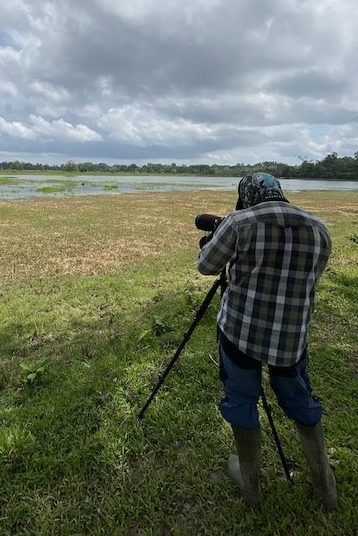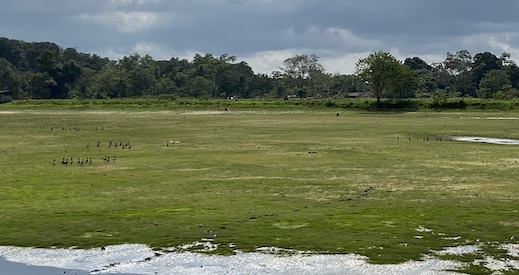As we walked by some of the former shrimp ponds in an abandoned aquaculture farm, we approached a scene I easily overlooked until Julian asked me to document what was happening. We saw an egret struggling to swallow something, and I simply assumed this was what a hungry egret looked like. However, Julian’s surprise and the wingbeat that seemed to come out of the egret’s beak revealed a more uncommon scene. Through our binoculars, we soon realized that the egret was struggling to swallow another waterbird—to Julian’s fascination, a seemingly undocumented behavior for this species. Skeptical of what he suspected he was witnessing, Julian got as close as he could to the scene and took photos while I made short videos from afar, worried that I would disrupt the egret and its prey if I moved any closer.
Julian was captivated by the scene and the opportunity to witness such an encounter. Although he has spent countless hours walking this site and documenting bird life there by himself or with fellow birders from Tumaco, in Colombia’s south Pacific coast, he also knew that myriad interactions, sounds, colors, and wingbeats occurred on this site that remain unexplored. However, Julian’s enthusiasm did not only respond to what he presumed would be a meaningful addition to the ornithological understanding of this species’ behavior. One of the founders of Tumaco’s only birdwatching club and with a background in biology, he has assumed a responsibility to report and circulate the myriad of unexplored forms of life that inhabit the ruins of this aquaculture farm.

Birding in the ruins of an aquaculture farm in Colombia’s south Pacific coast. Photo by author.
In this piece, I explore the life forms that emerge in the ruins of capitalist dreams and the production of modest forms of evidence that seek to render them visible. I see the sensorial practices prevalent among birders, such as long walks, careful listening and observation, and close attention to seemingly trivial acts (feeding, nesting, mating) as forms of evidence-making (Lyons 2018) in the ruins of a once prosperous aquaculture farm. A form of evidencia-para-hacer-pensar (evidence to makes us think) (Weinberg et al. 2020), these practices also function as modest forms of hope (Kirksey and Chao 2022) that seek to reimagine human-bird interactions in times of political transition in post-conflict Colombia.
An abandoned shrimp farm
One of the country’s most successful industrial shrimp farms throughout the 1980-90s, Maragrícola is an abandoned site that once was home to cutting-edge equipment, aquaculture experiments, crustaceans, and unruly microorganisms. A symbol of the dreams of progress and development of the 1990s in Tumaco, the more than 600 hectares of this farm accommodated hundreds of ponds used for industrial shrimp and tilapia farming. That was until the farm was forced to close by the mid-90s. Some in Tumaco suggest that the allegedly illegal origin of the owners’ fortunes had something to do with the farm’s debacle. Others remark instead that the deadly spread of the white spot disease was the factor that promptly annihilated shrimp farming and other aquaculture experiments there. However, many agree that the closure of Maragrícola signaled the end of a period of relative prosperity for this town and its hundreds of mainly Afro-Colombian inhabitants.[1] The collapse of Maragrícola is thus remembered by many as the beginning of the consolidation of two plantation economies that have shaped human and more-than-human lives there for the last decades: oil palm and coca.

In a report from 1991, El Tiempo newspaper commented that the industrial shrimp farming in Tumaco was a “factor of progress” for the city. El Tiempo, May 31, 1991. Photo by author.
The mid-90s was the time, as the actresses of the Teatro por la Paz collective in Tumaco portray in their plays, when armed violence became widespread and atrocious there. Together with the violence and historical injustices of anti-black racism and poverty, the guerrilla and right-wing paramilitary violence of the 2000s prompted religious and human rights leaders of Colombia’s Pacific coast to declare a humanitarian crisis in the region. The 2016 peace agreement between the Colombian government and the FARC guerrilla is thus seen by many in the Pacific region cautiously. It might take years until the effects of a peace agreement materialize here. The recent violence associated with drug trafficking and the systematic murder of social and community leaders has deepened a sense of hopelessness among many in Tumaco. For others, the peace agreement represents a historical scenario to promote the region’s biodiversity while reimagining forms of relatedness between humans and other forms of life that thrive in this biologically diverse area.
Evidentiary ecologies
The ruins of Maragrícola attract the most varied bird life, mainly migratory waterbirds that spend the Northern Hemisphere winters in these warmer water ecosystems. Abandoned human-made water forms have been rapidly adapted (and adopted) by local and migratory birds as the site for a multiplicity of interactions that still amaze local birdwatchers. This dynamic has transformed Maragrícola into one of the country’s top bird-watching destinations. Located in a privileged zone for migratory birds in Colombia’s south Pacific coast, Tumaco’s land and coastal landscapes are a node of a more extensive and complex network that transforms this coastal city, in the words of one of Tumaco’s most experienced birders, into an area where birds come to “pasarlo bien, sabroso” (thrive).
This understanding of Tumaco as a central node in this complex network is relatively recent. This was the same city that welcomed American naturalist William Blaney Richardson (1868-1927) in August 1912 as he embarked on a journey to collect bird specimens in this area for the American Museum of Natural History (AMNH). Contrasting with today’s perception of bird life in Tumaco, Richardson seemed unimpressed when he wrote, “As this is a small island surrounded by many others, an archipelago of islets and mangrove swamps there is very little to do here—a few common birds” (William B. Richardson to Frank Chapman, 2 August 1912, General Correspondence, Archives, Department of Ornithology, AMNH).
Later that day, after encountering the egret, I realized that Julian’s excitement about the waterbird also indicated a profound tension. As we walked to the farm’s main entrance after ten consecutive hours of birding, I felt confident expressing my concern about the future of Maragrícola. Although I referred to it as an “abandoned” site above, part of it is now transforming into an experimental farm for educational purposes, and a small farmers’ association is using other portions of the farm in the hope of restarting an aquaculture business. I asked Julian, what if those transformations mean you won’t be able to enter the farm and bring birdwatchers here anymore? To which he responded confidently that he and the birdwatching club’s members would put up a fight. What would happen to all the forms of avian life that have prospered in the ruins of this shrimp farm? How do birds intersect with the projects of the Afro-Colombian small farmers pursuing a collective shrimp farming business? Julian’s excitement about documenting the egret’s behavior thus seemed to me an instance of an evidence-making project to protect bird life in this contested site.
Lyons (2018) has shown how small farmers’ everyday reparative, material practices that seek to transform the toxic legacies of chemical exposure produce “evidentiary ecologies” that function as “an alternative form of evidence-making” (416) in a context where multiple forms of violence intersect. Inspired by this concept, I think of Julian and fellow birders’ work of documenting birdlife in Maragrícola as a practice of evidence-making. Through sensorial practices of close attention to the seemingly mundane life forms of migratory, resident, and endemic birds, Julian and his fellow birders have collected the data to write two peer-reviewed papers published in influential ornithology journals. In Julian’s own words, this would serve as one of the components in the “fight” they would give in a scenario where they would not be able to do birding on the shrimp farm anymore.
This work is accompanied by education campaigns, especially with Afro-Colombian children and youth from Tumaco, about avian life and biodiversity more broadly. The annual Festival Comunitario de Aves Playeras y Ballenas (community festival of shore birds and whales), organized by the birdwatching club every year since 2021, seeks to expand the community’s interest in birds and migratory whales through activities such as community birdwatching and public conferences.

Bird life in Maragrícola. Photo by author.
Through peer-reviewed papers and community activities, Tumaco birders are not only mobilizing the idea of the extraordinary biodiversity of this region and the urgency to implement conservation programs. One of their main goals is to invite the Tumaco community to acknowledge and enjoy the biological diversity of their territory in a context in which armed violence and other structural forms of violence have become ubiquitous. In this sense, I think of the work of Tumaco birdwatchers in relation to what Weinberg et al. (2020) call evidencia-para-hacer-pensar (evidence to makes us think). Introduced in relation to the work of the ethnographer and the production of anthropological evidence, I see this form of evidence operating in the work of Tumaco birdwatchers. As described by Weinberg et al. (2020) for the case of the Atacama Desert, since scientific knowledge is seen as providing “valid” evidence, communities adjacent to the Atacama salt flats use this scientific knowledge to validate something that people there already know: that the desert if full of life. In the case of Tumaco, the papers and community activities led by Julian and fellow birders mobilize something that many already know—that despite the common perception of this region as a violent frontier, many life forms thrive in this coastal landscape.
The data contained in the published papers—and the long walks, the careful observation, the attentive listening, and the disposition to documenting a species’ forms of life that produce such data—constitute modest acts in an ongoing effort to imagine “interspecies alliances” (Kirksey and Chao 2022: 9) in the once prosperous aquaculture farm. In a context in which the promises of the peace agreement of 2016 are yet to be realized, birding in the ruins of past capitalist dreams emerges as a modest form of hope toward a more just multispecies future.
Notes
[1] Escobar (2008) described how Maragrícola and other camaroneras (shrimp farms) employed few workers directly but created many jobs in the fish- and shrimp-processing plants in Tumaco. There, Escobar remarks, working conditions were unfavorable for the many Afro-Colombian women employed by these processing plants (87). Additionally, Escobar notes that shrimp farms such as Maragrícola contributed to the destruction of mangrove forests and environmental degradation in the area, mainly due to their intensive use of chemical inputs and the residues that industrial aquaculture produced.
References
Escobar, Arturo. 2008. Territories of Difference: Place, Movements, Life, Redes. Duke University Press.
Kirksey, Eben, and Sophie Chao. 2022. “Introduction. Who Benefits from Multispecies Justice?” in Sophie Chao, Karin Bolender, and Eben Kirksey (eds.) The Promise of Multispecies Justice. Duke University Press.
Lyons, Kristina. 2018. “Chemical Warfare in Colombia, Evidentiary Ecologies and Senti-Actuando Practices of Justice.” Social Studies of Science 48 (3): 414–37.
Weinberg, Marina, Marcelo González Gálvez, and Cristóbal Bonelli. 2020. “Políticas de la evidencia: entre posverdad, objetividad y etnografía.” Antípoda. Revista de Antropología y Arqueología 41: 3–27.
